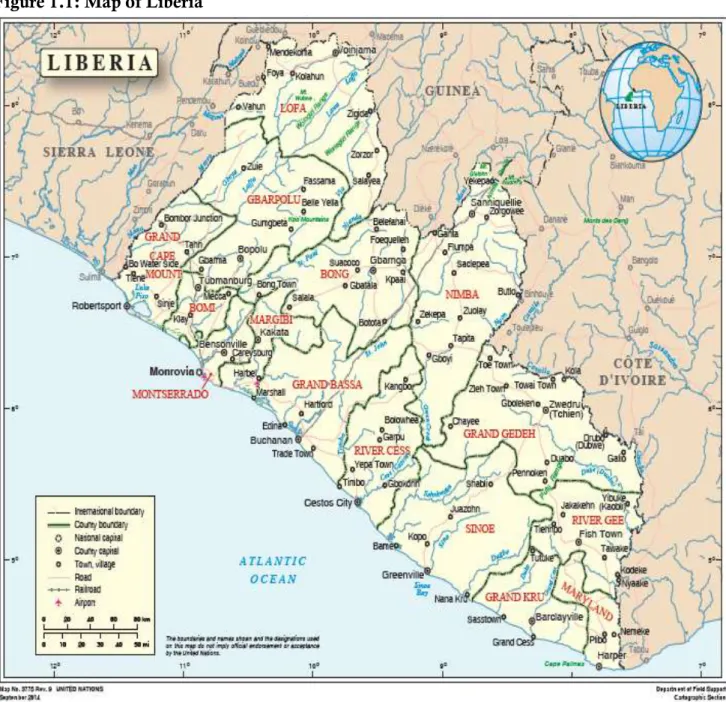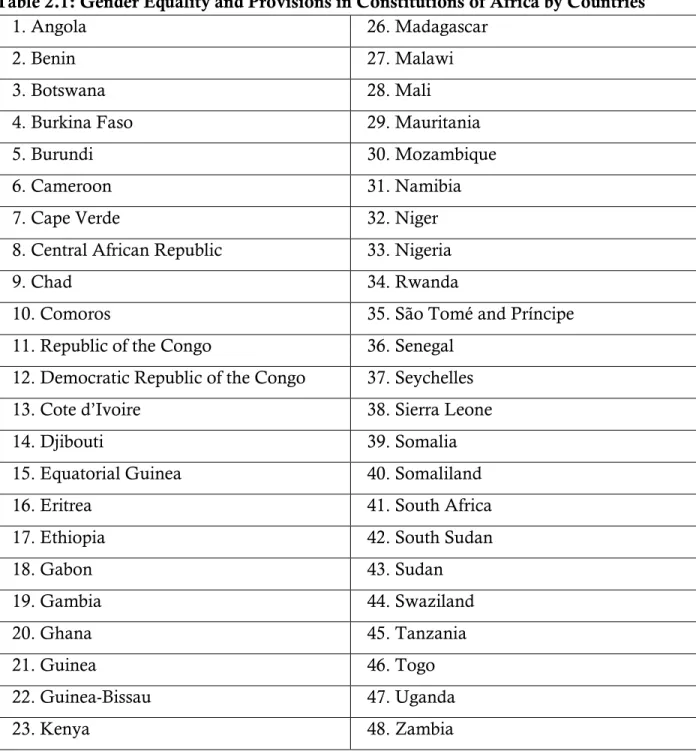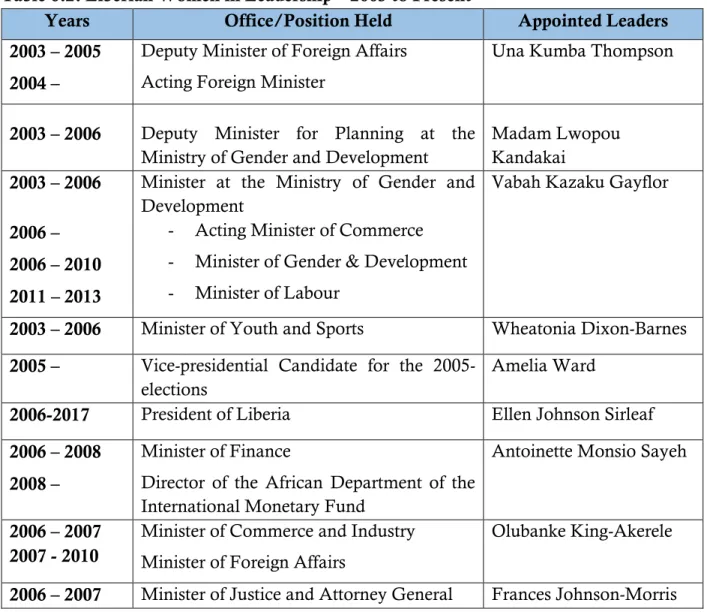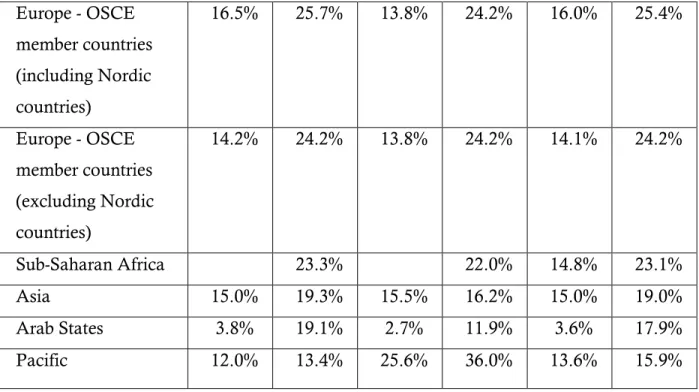It provides a nuanced perspective and context of the role of women and women's organizations in Liberia's peacebuilding architecture using a qualitative research methodology that consists of the assessment of relevant secondary information and primary data generated from focus group discussions and semi-structured interviews with selected women's organizations. institutions and individuals in Liberia. Keywords: post-conflict societies; Women and women's organizations; Liberia; Policy instruments; Framework for post-conflict peacebuilding, reconstruction and development; and Maxine Molyneux's organizational theory.
Introduction
This profiling is necessary in this chapter to uncover an understanding of both the specific and general underpinnings of the study's research problem related to the topic of women and peacebuilding. The chapter further defines the parameters of women's peacebuilding discourse and sheds light on the research hypothesis, objectives, questions and significance of the study.
Background of the research
Historic overview of the Liberian case study
English is the official language of Liberia, although there are 20 more languages spoken by the various ethnic groups. Ultimately, the third coup by Charles Taylor against Doe's government in 1989 marked the start of Liberia's civil wars that lasted until 2003.

Synopsis of Liberian conflict history–1989 to 2003
The United Liberation Movement of Liberia for Democracy (ULIMO) was formed by supporters of the late Samuel Doe. WIPNET Women of Liberia mass action for Peace and non-violent campaign for peace begins.
A brief on women’s initiatives towards ending the civil wars
Parameters of the women-peacebuilding discourse
True's further assertions point to the realities of women's roles in peacebuilding, which are often complicated by the limitations or failure of post-conflict policies to equally address the socio-economic injustices faced by women before and after conflict. It further explores the implications of the role of women in peace, security, socio-economic and political development in post-conflict reconstruction plans.
Research framework
The selection of the organizations is due to their visibly active roles in Liberia's years of conflict and the proactive contributions they continue to make to the effective reconstruction of Liberia, nationally and locally. The availability of sufficient public support and resources to consolidate women's involvement in peacebuilding and reconstruction activities at all levels of society.
Research questions
Research objectives
Purpose and significance of the research
How the directive definition of interests and the transformation of the practical into the strategic provided a platform for women's participation and influence in Liberia's current environment. It also aims to serve as a possible tool for women's organizations, policy makers and other stakeholders involved in monitoring and strengthening effective post-conflict development processes in Liberia and beyond.
Structure of the research
Chapter six examines the complementarity of government, local, international institutions and women's roles in Liberia's peacebuilding architecture from the perspective of an interpersonal support platform. UNSC Resolution 1325 to empower and promote women's political participation and governance represents efforts to address some of the challenges to women's roles in Liberia's peacebuilding architecture.
Conclusion
It was deemed necessary to understand the basis for women's evolving peacebuilding roles and the background of what constitutes the parameters of the women's peacebuilding debate. Furthermore, the chapter identified the research problem, and encapsulated that the leitmotif of the study is a comprehensive assessment of women's role and limitations, and therefore uses the framework of post-conflict peacebuilding, reconstruction and development, and the organizational positioning of what women underpin. organizations.
Introduction
This literature lays the foundation for a better understanding of various developments that embody the recognition and rights of women, women's associations as organizations that reinforce the goals of peace, and the responsibility of post-conflict peacebuilding. Yet against the backdrop of this scholarship and literature, the scarcity of research/knowledge gap on women and peacebuilding in (post)conflict persists, which is identified in this chapter and further underlines the relevance of the research.
Historical perspectives of women’s roles in the African contexts
- Social context
- Economic context
- Political context
- Peacebuilding context
The inevitable connection between the social and the political lay in the socio-cultural. In essence, it is resolute to construct that the prominent role of women in pre-colonial times was symbolic of both agency, leadership and marginalization, qualities that are present today and in continuity.
Deconstructing the women and peacebuilding nexus in the context of current debates
Women as conflict instigators and combatants
For example, during the night and in the privacy of their bedrooms, the tactical language and subtlety of women in expressing their grievances about the consequences of the conflicts and the. Therefore, it must be understood that the impact and new strength of women inside and outside the battlefield contributes to their stepping out of the background and taking on an active role as fighters and conflict instigators in the context of the above discourse.
Women as caregivers and peacebuilders during conflict and in post- conflict
The literature on women and peacebuilding in Liberia generally reveals that remarkable progress has been and continues to be made in the recognition, inclusion and representation of women in post-conflict processes in Liberia. While Long (2008), Cibelli, Hoover and Krüger (2009), Pillay (2009) and Tripp (2015) also describe the inclusion, representation and empowerment of women in processes of justice and reconciliation and socio-economic well-being in the workplace. -Liberia conflict.
International policy context on women and peacebuilding
The Beijing Platform for Action (BPfA)
At the heart of this policy is the strengthening of the role of women, participation in decision-making processes, and above all, the establishment and confirmation of the rights of women and girls as human rights. In addition, the conference in Beijing also set the goal of 30 percent of women in parliaments by 2005.
The UNSCR 1325 on Women, Peace and Security (WPS)
In particular, it signaled the beginning of our contemporary and widely-confirmed international perspective and importance of the role of women in peace and security interventions, thereby establishing a change in the chapter of policy processes. 24. UNSCR Need to increase participation of women in peace and security management at all levels; creation of global indicators to map implementation of UNSCR 1325.
Protocol to the African Charter on the Rights of Women in Africa
Paxton, Hughes, and Painter (2009) generally argue that the underrepresentation of women in national political affairs remains remarkably high. That the past fifteen years (2000 to 2015) since UNSCR 1325 have seen a significant increase in the percentage of women in parliament is indisputable.

Women’s organizations in peacebuilding
27 Women NGOs Secretariat of Liberia (WONGOSOL); Mano River Women’s Peace Network (MARWOPNET); National Women's Commission of Liberia (NAWOCAL); Liberian Women Law Enforcement Association (LIFLEA); Network for Women in Peacebuilding (WIPNET); Development Education Network -Liberia (DEN-L); and Ganta Concern Women Development Association (Ganta Concern Women), etc. It interrogates the role of women under the auspices of women's organizations in the context of peacebuilding architecture in Liberia.
Conclusion
These challenges, in turn, speak to the gap in scholarship, which drives the theory building of the study in the chapter that follows on peacebuilding, reconstruction and development in the post-conflict environment, and women's organizations. Theoretically, the following chapter therefore points to the collective need and importance of women's organizations in engaging the pillars of post-conflict peacebuilding, reconstruction and development activities.
Introduction
This theory focuses on women's practical interests and its transformation into strategic interests that support their sense of agency and operative organizational purposes for active involvement in post-conflict developments. Both theories (post-conflict peacebuilding, reconstruction and development, and Maxine Molyneux's organizational theory) are relevant to this study as they align the role of women with the post-conflict agenda.
The framework of post-conflict peacebuilding, reconstruction and development
- Security (security sector reform/transformation)
- Justice and reconciliation
- Socio-economic well-being
- Governance and participation
Rwanda's post-genocide dispensation35 represents a good example of the viability of post-conflict justice initiatives. Building good governance and fostering participation are essential to the implementation and sustainability of the goal of peacebuilding, reconstruction and post-conflict development.
Maxine Molyneux’s organizational theory
Women’s practical gender interest
Meanwhile, this does not mean separating women's practical sexual interests from those that are strategic. In light of women's practical sexual interests, then, the fundamental question becomes whether to realize the interests or to incorporate more transformative strategies that will address what triggered their lack or inaccessibility in the first place.
Women’s strategic gender interest
Within the framework of organizational theory, Moser points out that the nature of women's strategic interests or needs is challenging at all levels of society. It is perhaps important to emphasize that Molyneux's organizational theory supports the context of women's management and development.
Rights-based approach to peacebuilding
In addition, this canon of human rights underpins a rights-based approach. To structurally and systematically integrate the principles of human rights into the processes of peace building and development;
Conclusion
In anchoring the analysis, it sought to locate the role of women in post-conflict recovery agendas by postulating the agency of women's organizations and women's gender interests, as proposed by Molyneux, as the driving force behind their involvement, representation and inclusivity in the society. processes. While these theoretical considerations are contextualized in chapters five through seven on data presentations, analyses, and findings, the next chapter discusses the research methodology and methods used in this study to answer the research questions and achieve its objectives.
Introduction
Research paradigm
Methodological approach
The use of qualitative research method in this study was descriptive narrative in the form of focus group discussions and semi-structured interviews. Baxter and Jack thus emphasize the importance of context in case study design as a necessary consideration when examining the unit of analysis to better explain the phenomenon and the actual setting in which the event occurred.
Sources of data collection
The use of semi-structured interviews in this study made it possible to compare and interpret respondents' views due to the formatted and standardized nature of the questions (Barriball and While 1994:330). Likewise, these sources were valuable and powerful for building the theoretical and textual background of this dissertation.
Sampling method and sample population/size
In addition, three (3) semi-structured interviews were conducted with one leader and two members. As already explained, two focus groups were conducted with the same organization due to the participation of the members involved in the discussion.
Method of data analysis
Research on Women's Narratives (2007) elaborates on the power and importance of using narratives as a mechanism to present women's stories and experiences. Kroc Institute for Peace & Justice in the United States, which particularly encapsulates the context of women's experiences of war and conflict, and their approaches to peace through narratives.
Ethical considerations
The Study on Women's Narratives (2007) draws attention to the fact that "the actual power of a narrative is its potential to illuminate a social problem and create social change" and accounts of women's experiences of peace-seeking in Liberia capture the essence of this power of social change. Given that this study aimed to 'explore' and determine the transformative depths of peacebuilding processes and women's roles in them in (post)-conflict, taking the narrative approach therefore resulted in a true reflection of this.
Limitations and challenges of the study
This is in the sense that I carefully analyzed and assessed relevant secondary data and juxtaposed with some of the responses from the participants as presented in the analysis chapters of this study. Prior to the Ebola outbreak, I had informed most of the target group that interviews and discussions would be conducted in the months of November and December 2014.
Conclusion
The following chapter is the first of the data analysis and presentation of the research results chapters of this study. LIBERIAN WOMEN AT PEACE AT PEACE: EXPERIENCES AND APPROACHES OF WOMEN'S ORGANIZATIONS I (POST-).
Introduction
Through these presentations, the historical arrival of women's organizations in Liberia and their journey to the place where they are currently as peace builders is ascertained. It also assesses the broad horizons of women's strategic interests spanning their various networks of organizations in Liberia.
Women organizing for peace: the narratives and strategies
Women’s individual agency in conflict times
From this, women's agency in the context of this study is categorized as their ability to take advantage of the challenges. The topic of women's participation in Liberia parallels the events of crucial international events.
Women’s organizations, peace agencies and strategies in conflict times
- Advocacy campaigns
- Peaceful demonstrations
- Attending conferences/dialogues and peace talks
Meeting for conferences and dialogues is one of the many ways through which the involvement of women in peace processes occurs (UI-6 July 2015). Apparently, this success was symptomatic of the important steps that women's agencies and organizational strategies were contributing towards ending the conflict.
Women’s organizational roles and approaches in the post-conflict
- Women and security sector reform in post-conflict Liberia
- Women, governance and participation in post-conflict Liberia
- Women, justice and reconciliation in post-conflict Liberia
- Women and socio-economic wellbeing in post-conflict Liberia
Of course, Liberian women's interventions in the country's affairs are vital to her national reconstruction goals. The process of governance and participation constitutes one of the central pillars in the framework of post-conflict agendas.
Conclusion
Therefore, questions about how the government implements this and strengthens women's peace-making efforts in the process are dealt with in the following chapter. As such, the chapter established that the meaningfulness of women's efforts stems from their urgent need for peace and security that is inclusive for all and takes into account the interests of the people, which explains their participation in the processes from the very beginning.
Introduction
In conjunction with the foregoing, this chapter assesses the role of government, local, international institutions in Liberia's peacebuilding architecture, focusing on how they complement or strengthen women's agency and participation in the process. To what extent has Liberia's post-conflict gender politics of a female president influenced or defined the current positioning of women's role and participation in politics and decision-making processes of the state.
Early recognition of Liberian women in public leadership
From the vantage point, the holding of the Beijing conference was an empowering event that gave a voice to women worldwide, especially Liberia, because of the conflict and women's already active efforts at resolution. Consistent with this view, UI-5 also maintained that the outcome of the Beijing 1995 had indeed pushed Liberian women to be more assertive in their pursuit of peace.
Liberian government in post-conflict development: enhancing women’s peacebuilding and
- Supporting women’s political participation and governance
- Strengthening women’s participation in SSR and TRC processes
- Addressing women’s interests through the adoption of national policies and strategies
- The woman president factor and the advancement of women’s position
Acting President during the absence of the President and Vice President Deputy Minister of Gender Affairs and. According to UI-4 (July 2015), Liberia's NAP institution, as is the case with other UNs.

Local and international organization’s support for women’s agency and peacebuilding role
Local support for women’s role: case of the PUL
International support for women’s efforts: case of the UNMIL-OGA
Conclusion
Introduction
Barriers to women’s peacebuilding roles in Liberia
Under-representation of women in political leadership and decision-making processes
Sexual and gender-based violence
Patriarchy and ingrained cultural practices
Lack of financial resources for projects and organizational sustainability
Disunity and class divide among women organizations
The capacity building challenge
Conclusion
Introduction
Summary of the research findings
Recommendations to women’s peacebuilding challenges
Contribution of the study
Suggestions for further research
Profiles of Organizations that Participated in this Study
Women Rising for Peace - A Narrative
Publication Outcomes of the Study
Gatekeepers Letter for Field Research in Liberia
Cover Letter and Document of Informed Consent
Ethical Clearance Letters - UKZN
Interviews and Focus Group Discussion Questions
Pictures from Field Research in Liberia


